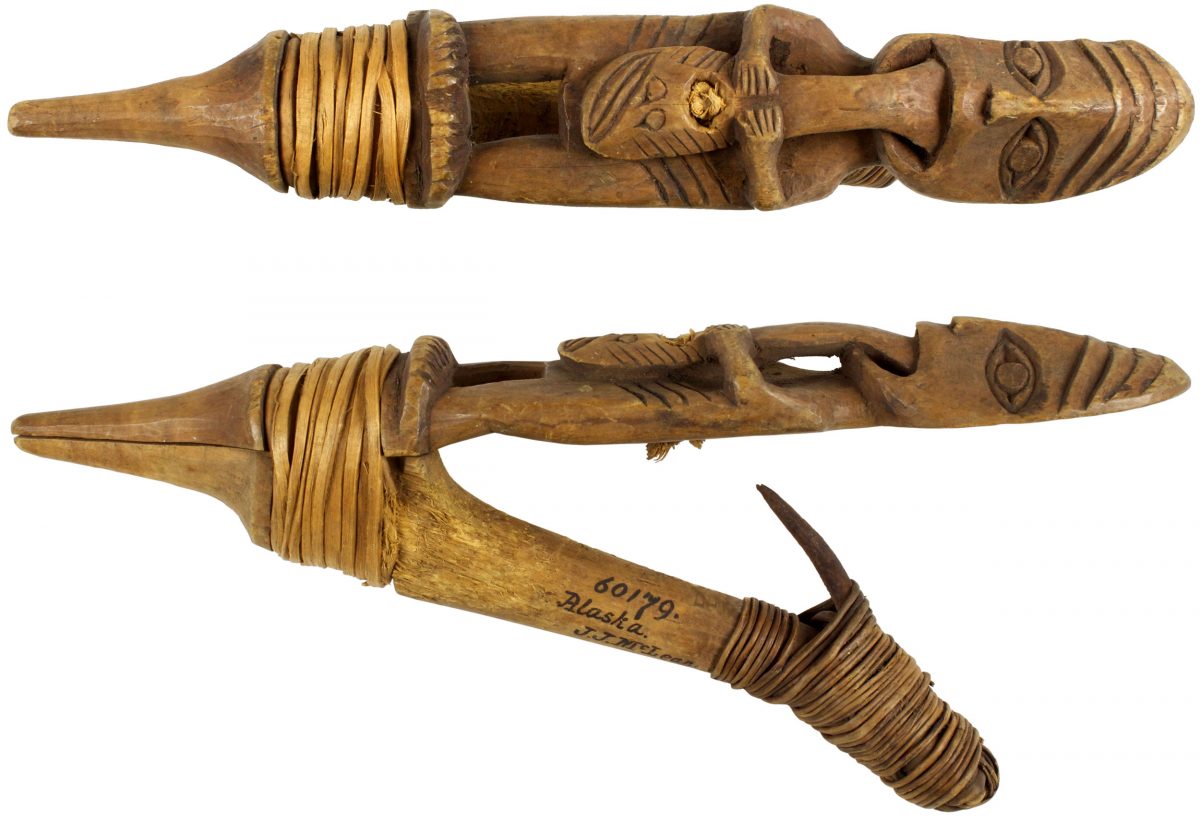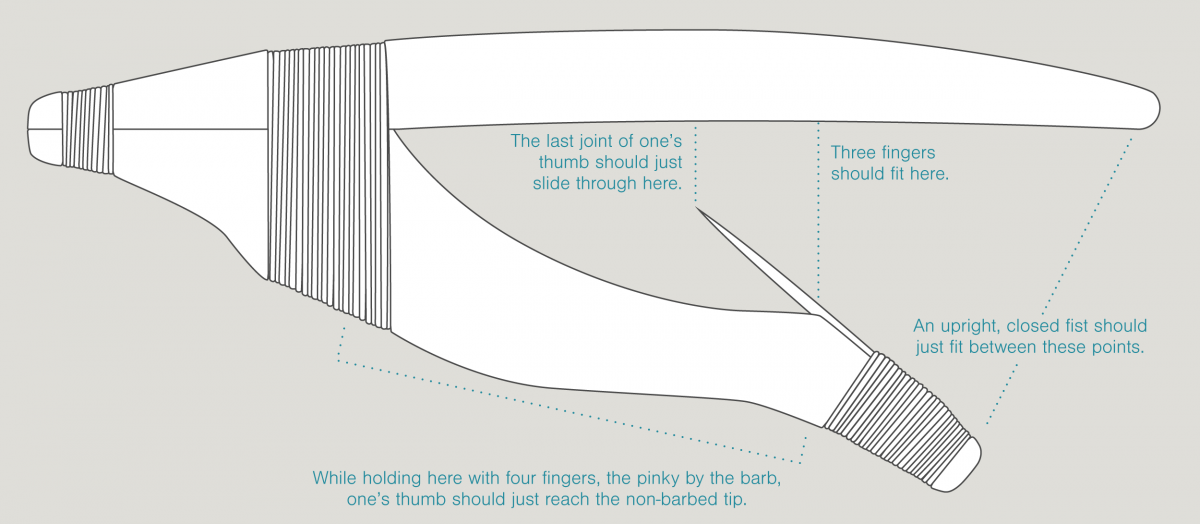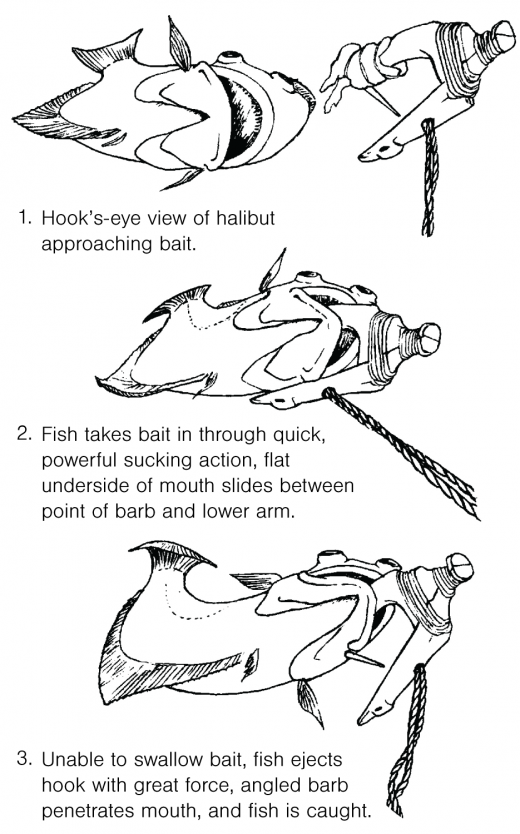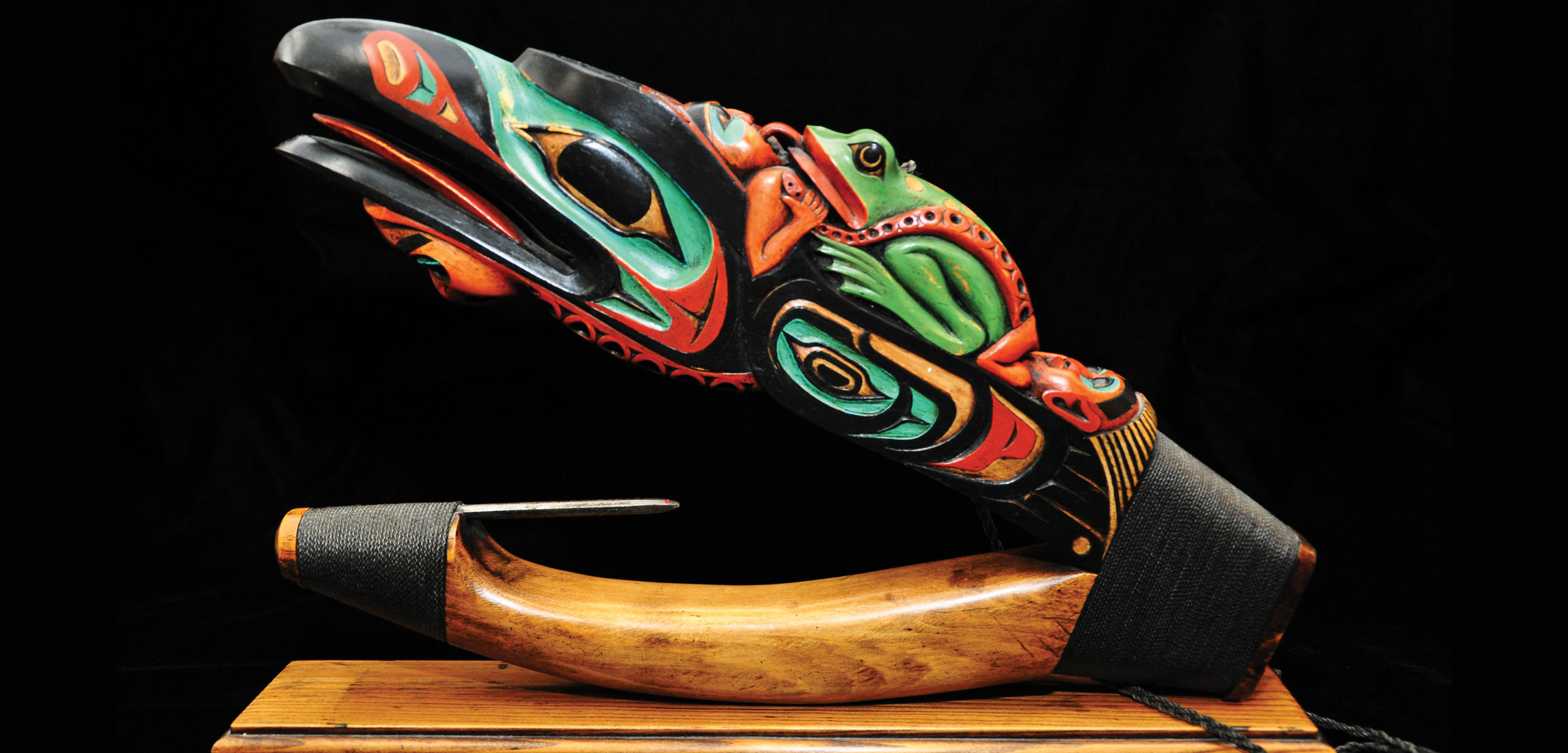The Halibut Hook Revival
An ingenious Indigenous fishing technology with spiritual significance is making a comeback.
Article body copy
Jonathan Rowan lowers his handmade wooden halibut hook into the tranquil early-morning water off Klawock, Alaska, and urges it to go down and fight: “Weidei yei jindagut,” he says in the Tlingit language. From his skiff, the tribal leader, who is joined by two friends, watches the V-shaped hook about as long as his forearm slowly sink and hopes the imagery he carved on the seafloor-facing arm—a beaver perched on a chewed stick—entices a halibut.
Rowan, a master carver, is acting on an omen. The previous morning, the hook had fallen off a cup hook in the ceiling of his workshop and landed between him and his friends as they were having coffee and discussing where to fish. “That’s a catcher right there,” Rowan had said, selecting the hook from his collection of about eight for today’s expedition. The wooden buoy bobbing in the water will let him know if he’s right—also carved to look like a beaver, the tail will start slapping the surface if a struggle is underway beneath the waves. As Rowan surveys the scene, he pictures his ancestors setting hooks in the same spot, reciting the same words of encouragement, and, hopefully, having the same good luck.
Indigenous peoples of the northwest coast of North America have been hauling in halibut on what are known colloquially as “wood hooks” for centuries, but very few fishermen use them today. In his community of about 800, Rowan can count on one hand the people who practice this traditional technique. Over time, wood hooks were replaced with off-the-shelf fishing equipment with no assembly, or artistic aptitude, required.
As the hooks came out of the water, they found new homes on land as art pieces and collectors’ items. In fact, many carvers started making hooks specifically to hang on the wall rather than above the seafloor. But now, Rowan and other carvers are trying to revive the ancient tradition by teaching people how to make and use the hooks for what they were intended, and helping them reconnect with their culture in the process.

This early halibut hook from the Tlingit tribe Xootsnoowú (fortress of brown bears) was collected in Angoon, Alaska, by John J. McLean in 1882, and is now in the collection of the Smithsonian’s National Museum of Natural History. The figural element on the 28-centimeter-long hook depicts an unknown being eating, or spiritually connecting to, a halibut. Photo courtesy of Jonathan Malindine
Some days, Rowan drops a longline with 30 hooks, but the experience of sending down a wood hook is completely different. For him, the connection to his culture and his land feeds his soul—and his family. “There’s personal satisfaction in taking the same steps to make these hooks as my ancestors did and then being successful, too,” he says. “It’s a good feeling knowing that what you created has provided.”
And provide they do.
As Rowan returns to where he set his hook after his friends dropped their longline at a different spot, the beaver is nowhere to be seen. As they scan for what Rowan calls his “tattletale buoy,” it splashes to the surface and the tail starts slapping. “See guys, I told you it was a catcher,” Rowan says. The longline didn’t catch a single halibut. In fact, Rowan says he has just as much success with his wood hooks as he does his modern gear, in part because they’re technically ingenious, but also because they work on a spiritual level.
The practice of making halibut hooks has been handed down through the generations—literally. Carvers use their hands to determine the angles and dimensions, which some believe allows them to target fish of different sizes. A recent study exploring how and why the dimensions of hooks have changed over time found that early hooks—primarily dating from 1860 to 1930—caught fish between nine and 45 kilograms, sparing the juveniles and the most prolific breeders, thus sustaining the species for future generations. It’s an extraordinary example of traditional ecological knowledge being shared through an object, says study author Jonathan Malindine, a PhD candidate in anthropology at the University of California, Santa Barbara.
To make the hooks, carvers shape two pieces of different wood into arms: yellow cedar is traditionally used for the upper arm because it’s buoyant and halibut are apparently attracted to the smell, while a heavier wood, such as Pacific yew, anchors the bottom. The pieces are lashed together with twine, though braided bull kelp and cordage made from cedar bark or spruce root were historically used. “You’ve got to tie it super-tight or the hook will come apart,” Rowan warns. “The halibut will twist it around to show you that you didn’t do it right.”

All of the measurements needed to make a halibut hook are in your hand. Illustration by Mark Garrison
A barb is secured to the upper arm—in the past, a sliver of black or brown bear femur was used, but today a sharpened nail does the trick—and herring or octopus is typically used for bait. The hooks are perfectly designed for how their targets feed: halibut don’t delicately nibble at their meals; rather, they suck up their prey like mini-Hoovers. If a halibut senses something undesirable in its mouth, it’ll spew it out with gusto. When that something is a barb, the act of ejecting it drives the spike deep into its maw. Escape is virtually impossible.
But the scent of cedar and the taste of herring aren’t the only things that lure halibut. The images carved on the hooks are believed to attract the fish by showing them respect, while also offering fishermen spiritual assistance at sea, which may be needed because halibut are often big, powerful, and found far from shore.
The carved imagery frequently features the shaman, a being with supernatural powers such as curing the sick and controlling the weather, and animals associated with power and mythology, such as the raven, octopus, and even halibut. The shaman, who seamlessly traverses the natural and supernatural worlds, is believed to help fishermen make similarly smooth transitions from land to sea. Malindine notes that many of the animals carved into hooks have a real-life ability to move between environments, adding that one such example is the river otter, which “can swim almost like a fish and run through the forest like a rabbit.”
For his study, Malindine spent nearly a month at the Smithsonian Institution’s Museum Support Center, a collections storage facility in Suitland, Maryland, examining one of the largest collections of wood hooks in the world. He would slip on purple nitrile gloves, open drawer after drawer of wood hooks, and closely examine and photograph the specimens one by one. Later, he took 11 measurements to create a database. In total, he found 109 intact hooks dating back to 1867—some never used and others heavily patinated and covered in halibut teeth marks—as well as many fragments. He rounded out his sample with 25 contemporary hooks from art galleries and private collections, and found that over time, the hooks got longer to favor decorative elements rather than functional requirements.
Some of the images etched into the early hooks are forever etched into Malindine’s mind, including a group of frog-faced beings and a witch with bound hands and a pained face. Part of the job of the Tlingit shaman was to identify “bad” witches and capture, bind, and torture them until they had been rehabilitated, Malindine explains. “A lot of these hooks contain some really spooky imagery,” he says. “There’s a lot of mystery and mythology embedded in them.”

This 28-centimeter-long hook from Haida Gwaii, British Columbia, was purchased in 1937 by George Gustav Heye, whose collection of Native American artifacts became the core of the Smithsonian Institution’s National Museum of the American Indian. The figural element depicts a human transforming into a river otter. Photo courtesy of Jonathan Malindine
The images Rowan carves just come to him; from where, he can’t say. He recently spent two weeks crafting a hook featuring a sea monster and a shaman with a frog on his head. If a hook doesn’t catch after four attempts, he believes it’s not suited to his spirit and passes it on to the first person through his door. “I call it fishing magic,” he says. “It’s a supernatural kind of thing.”
Malindine, a former commercial fisherman who lived in Alaska for seven years, points out that the wood hook is also a rare example of an object that ties together the different domains that collectively form Alaska Native identity: mythology, art, carving, the subsistence lifestyle, and, most importantly, catching and eating halibut, which, he says, “is probably the biggest part of the Native identity up there.”
As a non-Indigenous person, Malindine wanted to ensure his research would have value for the source communities, so before he started his project, he discussed it with Rowan and other carvers, who told him they were keen on having access to photos and measurements of early hooks so they could reproduce them or simply see some of the work of their ancestors. The result is a book of photos and measurements of 33 early hooks entitled Northwest Coast Halibut Hooks. Malindine hopes the book will help buoy what he sees as a resurgence of interest in the wood hook; indeed it has already found its way into classrooms and workshops.
Every class Donald Gregory teaches on how to make wood hooks starts the same way: “If you agree to teach somebody else, I agree to teach you,” he says. “If you do that, we’ll continue.”
So far, no one has said no.
In Gregory’s earliest memory, a bright-orange buoy bounces along the water, a sign that his father, a fish buyer in the Alaskan village of Angoon, had caught a halibut with a wood hook. For a long time, that was Gregory’s only knowledge of traditional halibut hooks; he never learned about them in school. The Tlingit artist and facilities and special projects coordinator at Sealaska Heritage Institute in Juneau, Alaska, began carving wood hooks as an adult and selling them as art pieces. Today, he passes on his knowledge to students at Juneau-Douglas High School, inmates at Lemon Creek Correctional Center, and children attending cultural camps. “My basic goal is to pass it on so it won’t be forgotten,” he says. “There were a lot of scary times when a lot of our artwork was dying off.”

This graphic shows how a traditional hook catches a halibut. Illustration from Indian Fishing: Early Methods on the Northwest Coast by Hilary Stewart, 2018, Douglas and McIntyre. Reprinted with permission from the publisher
Those times have passed: halibut hooks have officially become part of the curriculum at Juneau-Douglas High School, and Sealaska Heritage has developed lesson plans for middle school students that use the hooks to teach math and science concepts, such as geometry and halibut biology, in addition to cultural knowledge. Rowan also teaches students how to make the hooks as the Native arts teacher at the community school in Klawock.
At the jail, Gregory’s workshops are helping Indigenous and non-Indigenous inmates alike learn a skill, appreciate the culture, and give back to the community. They can sell their hooks in gift shops, and if they owe fines or restitution, 80 percent of their earnings must pay down their debt; otherwise, it’s money in the bank to help them get established after they’re released. Artwork can also be donated to charity or sent home to loved ones.
“I can see that they’ve grown while they’ve been in jail and that they’ve got some pride,” Gregory says of the Indigenous inmates. “They were almost ashamed to admit that they were Native before. It makes me feel good to see that they’re enjoying learning their culture and participating in it.”
For Aleut inmate Aaron Phillips, learning about and making halibut hooks has shifted his perspective. “I have an opportunity now to give back,” he says in a Sealaska story. “I was always taking, taking and taking from everybody, society, my family. … It was these classes that made me think about my culture. I should be teaching my kids about who I am.”
Before the workshop, he didn’t even know what halibut hooks were. “I just thought they were art,” he says. “I didn’t know they were functioning pieces. I didn’t know any of it.”
Once the inmates are released, they can join weekly carving practices with Gregory, and a few have become regulars. One man was so keen, he collected the scraps from a plank of red cedar that was cut for a paddle to make half a dozen halibut hooks in his spare time. Recently, a high school student told Gregory that she had fulfilled her obligation to him by teaching others how to make the hooks. “That was the first time anyone told me that,” he says. “It made me feel really good.”
From quiet conversations after class to public declarations, the halibut hook is having a moment. In February, the wood hook was inducted into the Alaska Innovators Hall of Fame, the first Indigenous tool to be honored. “The halibut hook, which remains artistically and environmentally relevant after centuries of use, is the embodiment of Alaska Native ingenuity,” the Alaska State Committee for Research wrote in the citation.

Thomas Barlow caught this halibut on a hook he made in a course taught by his grandfather Thomas George. Barlow started joining his grandfather on fishing trips when he was a toddler, and the 14-year-old is now accomplished in the art of making and using traditional hooks. Photo by Thomas George
At the induction ceremony, Tlingit master fisherman and hunter Thomas George, who has fished with his handmade hooks for more than five decades, accepted the award. “I’ve been trying to get help to keep this part of our heritage alive for years or decades,” he told the crowd.
His greatest success was standing right next to him on stage: his 14-year-old grandson, Thomas Barlow.
Gregory recalls participating in a recent halibut hook class at Sealaska Heritage Institute led by George, who had brought along his grandson, one of his regular fishing companions. “That kid knew more than any of us put together,” Gregory says. At the end of the class, George told the students that they don’t pass until they send a photograph with a halibut on the hook. About a week later, George sent the students a snapshot of his grandson with a halibut nearly as big as him on the hook he had carved in class, telling them they have pretty stiff competition.
“My biggest fear was that the wooden halibut hook was going to die with me,” George says. “One of my greatest accomplishments in life was I was able to teach somebody who loves it with a passion. I know that it won’t die as long as my grandson is alive. He’s hooked.”

